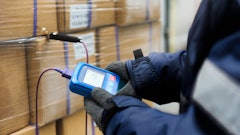
Over the past several years, the over-the-road (OTR) transport industry has been inundated with a surge in cargo thefts. Industry research reveals that incidents reached epidemic proportions in 2023 when thieves employed more sophisticated robbery schemes in addition to traditional methods. In the face of this escalating threat, stakeholders need to implement tools and technologies to help them protect shipments throughout the supply chain.
Comparing Q2 2022 to 2023, CargoNet recorded a 57% increase in cargo theft across the United States and Canada. Thefts were mainly focused on higher-value commodities, such as food, beverages and electronics. In Q2 2023 alone, thieves stole more than $44 million in shipments; the value per theft increased by nearly $100,000 to an average of $260,703.
The ongoing crime wave has revealed a shift from straight theft to strategic shipment misdirection attacks. Straight theft is simply when thieves physically find and steal a tractor-trailer where it’s parked such as warehouses, distribution centers (DCs), truck stops, parking lots and drop lots or break into its rear trailer doors.
Strategic theft is a rapidly growing threat that can be likened to the concept of personal identity theft. Thieves assume the identities of motor carriers and logistics brokers to obtain freight, misdirect it from the intended receiver, and steal it. Carrier identity theft, double brokering, fictitious pickup, extortion and conversion schemes all fall into this category.
Recent industry data speaks to the extent of the current challenge:
- Strategic cargo theft increased a staggering 430% from 2022 to 2023.
- 51% of all Q2 2023 cargo thefts took place in California, Texas and Illinois.
- Full trailer-load thefts have increased by 17%, year-over-year.
Despite improved law enforcement in higher-risk areas, the potential for high-value cargo theft remains a persistent threat.
3 ways a live tracking infrastructure can prevent cargo theft
According to cargo industry experts, tracking technologies have become mandatory tools for an effective cargo theft prevention strategy. Specialists recommend the use of integrated tracking devices on trailers and cargo — especially those that have route-fencing and geofencing capabilities — to add a much-needed layer of virtual security.
Cargo software, tracking devices and expert services can provide a collective toolset stakeholders need to help mitigate and prevent the theft of high-value shipments, providing real-time mapping, tracking, monitoring, geofencing and alerting capabilities.
Tracking devices also offer a variety of sensing capabilities, including cold chain temperature monitoring and light detection for security. Considering the historic wave of cargo theft, here are three ways tracking devices can help mitigate threats.
1. Monitor shipping routes.
Do you know exactly where your shipments are going and when they deviate from planned routes? A real-time tracking and monitoring program can help you oversee shipments and verify their current locations. If suspicious activities occur — such as unplanned rerouting or unexpected departures — you can contact the driver or carrier to confirm the reason for the deviation.
If you suspect a theft, immediately contact the local authorities and relay the shipment’s location. Live tracking provides a shipment’s location to local authorities to subsequently investigate and/or apprehend the thieves. A live mapping dashboard helps maintain visibility of shipper location, status and/or conditions.
2. Build a geofence.
Software with monitoring capabilities can be used to set up a geofence around known hotspots for cargo theft. A geofence creates a virtual boundary around a specific high-risk zone using onboard tracking devices and cellular triangulation technology.
When shipments enter or exit a geofence, this software can send alerts and put stakeholders on notice of the potential for suspicious activity. Live mapping capabilities monitor shipments until they have safely exited the geofence, as expected.
A geofence can be built to monitor specific routes or transfer locations, such as high-risk drop lots, DCs or warehouses. For example, if a shipment was planned to be staged until morning, and the geofence indicated unplanned movement in the middle of the night, stakeholders would be immediately notified. A full geofencing solution enables cargo experts to monitor, manage and respond to suspicious activities.
3. Catch thieves in the act.
You may not be able to entirely prevent cargo theft, but you can be notified when a potential heist is underway. By using tracking devices with built-in light sensors — in combination with robust cargo monitoring software — stakeholders can be notified as soon as trailer doors are opened.
If this occurs at a suspicious location (i.e., truck stop) or during an unexpected time frame (i.e., middle of the night), it’s a likely indication of breaking and entering. Tracking devices have multiple sensor options, including light sensitivity to indicate when trailer doors or a cargo pallet has been opened. Authorities then can use its live location tracking capabilities to guide their response.
Combat cargo theft with proactive shipment management
Considering the escalating threat of cargo theft and the emergence of strategic misdirection techniques, supply chain stakeholders simply can’t afford to take a passive approach to theft prevention. By employing a real-time tracking infrastructure and leveraging its advanced geofencing technologies around high-risk zones, companies can transition to a more proactive cargo security strategy.


















